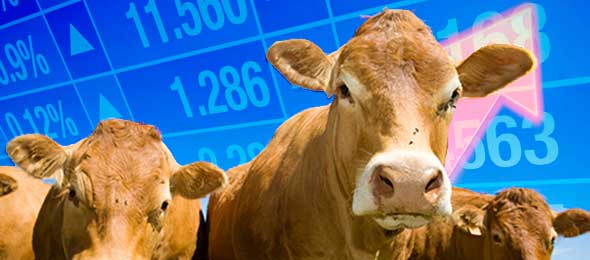Cattle Futures Jump After North American Trade Pact Signed

Chicago Mercantile Exchange live cattle futures rose to their highest prices since April on Monday after the United States, Canada and Mexico said they struck a deal on a trilateral trade pact
by Tom Polansek – Reuters
News of the agreement, reached over the weekend, eased concerns that the United States would exit the North American Free Trade Agreement (NAFTA) that has propelled U.S. agricultural export growth for a quarter century.
“The higher opening was probably some feel good news” about the trade pact, said Larry Hicks, president of CattleHedging.com
CME October live cattle futures settled up 0.225 cent at 113.675 cents per pound, after the nearby contract touched its highest price since April 12. Most-active December ended up 0.100 cent at 118.950 cents, after reaching a life-of-contract high at 119.750 cents.
“At first glance, we’re encouraged with efforts to modernize some chapters that specifically affect trade in agricultural goods”
CME October feeder cattle finished up 0.475 cent at 158.650 cents per pound. CME October hogs advanced 2.575 cent to 64.750 cents per pound and December hogs rose 1.925 cents to 59.850.
Tyson Foods Inc, the biggest U.S. meat processor, said the trade agreement was positive news.
“We look forward to the approval of a new deal and the removal of retaliatory tariffs and other trade barriers so that U.S. farmers and companies like ours can continue to expand in these important markets,” company spokesman Gary Mickelson said.
Last year, the United States exported to Canada 116,561 metric tons of beef worth $796 million and 237,972 metric tons worth $980 million to Mexico, according to the U.S. Meat Export Federation, a trade group.
Cargill Inc, one of the world’s biggest processors of ground beef, said it was important to determine whether the new agreement was better than NAFTA.
“At first glance, we’re encouraged with efforts to modernize some chapters that specifically affect trade in agricultural goods,” spokeswoman April Nelson said.
Demand for U.S. beef has been strong recently and prices for feed grains have been low, prompting cattle ranchers to expand their herds. The large number of cattle should put pressure on futures by the end of the week, Hicks said.
“We’ve got good demand supporting it,” Hicks said about the cattle market. There are “too many cattle to follow through” on recent gains, though, he added.
There were 11.1 million U.S. cattle and calves being fed for slaughter as of Sept. 1, a record for that date since the U.S. Department of Agriculture began tracking the data in 1996.












